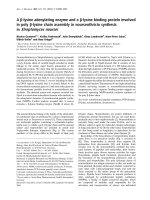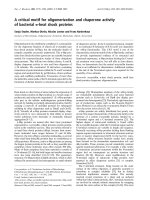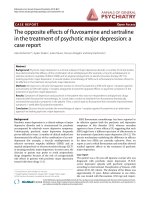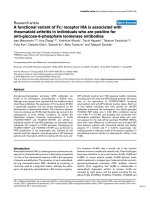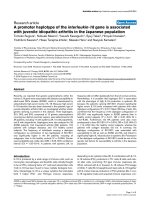Báo cáo y học: "A knowledge synthesis of patient and public involvement in clinical practice guidelines: study protocol" doc
Bạn đang xem bản rút gọn của tài liệu. Xem và tải ngay bản đầy đủ của tài liệu tại đây (311 KB, 8 trang )
BioMed Central
Page 1 of 8
(page number not for citation purposes)
Implementation Science
Open Access
Study protocol
A knowledge synthesis of patient and public involvement in clinical
practice guidelines: study protocol
France Légaré*
1
, Antoine Boivin
2
, Trudy van der Weijden
3
,
Christine Packenham
4
, Sylvie Tapp
1
and Jako Burgers
2
Address:
1
Canada Research Chair in Implementation of Shared Decision Making in Primary Care, Université Laval, Quebec city, Quebec, Canada,
2
Scientific Institute for Quality of Healthcare, Radboud University Nijmegen Medical Centre, Nijmegen, the Netherlands,
3
Department of General
Practice, School for Public Health and Primary Care (Caphri), Maastricht University, Maastricht, the Netherlands and
4
Ministère de la santé et des
Services Sociaux de Québec, Montréal, Québec, Canada
Email: France Légaré* - ; Antoine Boivin - ; Trudy van
der Weijden - ; Christine Packenham - ;
Sylvie Tapp - ; Jako Burgers -
* Corresponding author
Abstract
Background: Failure to reconcile patient preferences and values as well as social norms with clinical practice
guidelines (CPGs) recommendations may hamper their implementation in clinical practice. However, little is
known about patients and public involvement programs (PPIP) in CPGs development and implementation. This
study aims at identifying what it is about PPIP that works, in which contexts are PPIP most likely to be effective,
and how are PPIP assumed to lead to better CPGs development and implementation.
Methods and design: A knowledge synthesis will be conducted in four phases. In phase one, literature on PPIP
in CPGs development will be searched through bibliographic databases. A call for bibliographic references and
unpublished reports will also be sent via the mailing lists of relevant organizations. Eligible publications will include
original qualitative, quantitative, or mixed methods study designs reporting on a PPIP pertaining to CPGs
development or implementation. They will also include documents produced by CPGs organizations to describe
their PPIP. In phase two, grounded in the program's logic model, two independent reviewers will extract data to
collect information on the principal components and activities of PPIP, the resources needed, the contexts in
which PPIP were developed and tested, and the assumptions underlying PPIP. Quality assessment will be made for
all retained publications. Our literature search will be complemented with interviews of key informants drawn
from of a purposive sample of CPGs developers and patient/public representatives. In phase three, we will
synthesize evidence from both the publications and interviews data using template content analysis to organize
the identified components in a meaningful framework of PPIP theories. During a face-to-face workshop, findings
will be validated with different stakeholder and a final toolkit for CPGs developers will be refined.
Discussion: The proposed research project will be among the first to explore the PPIP in CPGs development
and implementation based on a wide range of publications and key informants interviews. It is anticipated that the
results generated by the proposed study will significantly contribute to the improvement of the reconciliation of
CPGs with patient preferences and values as well as with social norms.
Published: 4 June 2009
Implementation Science 2009, 4:30 doi:10.1186/1748-5908-4-30
Received: 24 March 2009
Accepted: 4 June 2009
This article is available from: />© 2009 Légaré et al; licensee BioMed Central Ltd.
This is an Open Access article distributed under the terms of the Creative Commons Attribution License ( />),
which permits unrestricted use, distribution, and reproduction in any medium, provided the original work is properly cited.
Implementation Science 2009, 4:30 />Page 2 of 8
(page number not for citation purposes)
Background
The challenge of clinical practice guidelines (CPGs)
implementation
Clinical practice guidelines (CPGs) are described as 'sys-
tematically developed statements to assist practitioner
and patient decisions about appropriate health care for
specific clinical circumstances'[1]. Within the knowledge
to action framework, CPGs are understood as the product
of a knowledge tailoring strategy, translating primary and
secondary research into specific recommendations for
action [2]. Their application in clinical practice is expected
to improve patient outcomes by promoting an effective,
equitable, and rational utilization of resources [3]. How-
ever, despite the vast amount of resources invested in
CPGs development, their implementation in clinical prac-
tice remains a major challenge [4]. As a result, appropriate
evidence-based care is not offered to patients, while
unnecessary or harmful care often is [5-9]. An important
barrier to the implementation of CPGs recommendations
is their inability to reconcile patient preferences and val-
ues as well as social norms [10,11]. CPGs have also been
criticized for not being responsive to increased demands
from patients to share decisions with health professionals
and play an active role in their care [12-14]. Furthermore,
current CPGs are leaving unaddressed some of the critical
challenges posed by the rising burden of chronic disease
and its impact on the context of decision-making. There-
fore, the role that patients and public involvement pro-
grams (PPIP) could play in CPGs development and
implementation is increasingly attracting the attention of
policymakers, health professionals, patients, and the pub-
lic.
The grey zone of decision making
Clinical decisions largely occur in contexts of scientific
uncertainty. These grey zone (or preference sensitive)
decisions are characterized either by scientific evidence
that points to a balance between harms and benefits
within or between options, or by the absence or insuffi-
ciency of scientific evidence [15-17]. Moreover, probabil-
ities of risks and benefits in a population cannot be
directly attributed at the individual level. Consequently,
both clinicians and patients need help in resolving uncer-
tainty when facing clinical decisions [18]. However, cur-
rent CPGs are insufficiently adapted to grey zone
decisions, and thus cannot help providers and their
patients make informed decisions in these highly preva-
lent decision-making contexts.
CPGs are still largely conceived as tools that should foster
adherence to a best decision defined by the 'expert health
professional', rather than instruments that should support
the best decision for a specific patient in a specific context.
Health professionals have criticized CPGs for lacking rele-
vant information to assist shared decision making with
patients [12,19]. In Canada, a large proportion of CPGs
development is undertaken by expert panels and, most of
the time, patient and public organizations have a limited
role to play or are at best asked to comment on draft ver-
sions of CPGs [20,21]. This is surprising because evidence
suggests that patient involvement might be beneficial at
different levels of health care. At the clinical level, it is
associated with the quality of the decision-making process
[22], reduction in unwarranted surgical interventions
[23], and patients' quality of life at three years [24]. At the
level of the population, patient involvement fostered by
patient decision aids has been found to reduce overuse of
options not clearly associated with benefits for all (e.g.,
prostate cancer screening) [25] and to enhance use of
options clearly associated with benefits for the vast major-
ity (e.g., cardiovascular risk factor management) [26]. The
most recent systematic review of the effectiveness of
patient involvement in decision making (or shared deci-
sion making) found this approach to be particularly effec-
tive in fostering adherence to the treatment choice that
was made in the context of chronic disease, more specifi-
cally in the context of mental health diseases [27]. Thus,
engaging patients as decision-makers, experts, and co-pro-
ducers of health is particularly important in this context,
as productive interactions between active and informed
patients and health care providers are understood as key
components to effective chronic disease management
[28,29]. As decision-makers in Canada are increasingly
focusing their efforts to tackle the rise of chronic diseases,
the relevance for involving patients in CPGs development
is thus becoming more pressing.
Beyond its role in assisting individual clinical decisions,
CPGs have also a broader impact on health policy, fund-
ing decisions, and service organization [30,31]. However,
social norms and economic judgments are largely implicit
and poorly articulated in current CPGs, which lead to
potential conflicts of interests, contradictions in CPGs rec-
ommendations, and confusion among health profession-
als, patients, and the public [12,32-34]. For example, the
Canadian Diabetes Association recommended in 2003
that insulin glargine could be used as an alternative to
generic long-acting insulin for the treatment of diabetes
[20]. After reviewing virtually the same evidence, the
Common Drug Review, a national advisory panel, recom-
mended that the drug not be listed in provincial formular-
ies on the basis of questionable added clinical benefit and
a five-fold increase in price [21]. Such controversies illus-
trate the grey zones of decision making and the impor-
tance that CPGs developers be accountable not only to
patients but also to the general public, which implies to
consider cost effectiveness and cost impact [33,35-37].
The McDonnell Norms Group suggests that response to
public demand and social norms be regarded as a key
ingredient for the successful implementation of research
Implementation Science 2009, 4:30 />Page 3 of 8
(page number not for citation purposes)
evidence in clinical practice [38]. Considering the perspec-
tives of patients and members of the public is thus a logi-
cal approach for conceptualizing the development and
effective implementation of CPGs.
International consensus on the importance of patient and
public involvement in CPGs
International experience of patient and public involve-
ment in CPGs has been accumulating in the past ten years
[39]. For example, the British National Institute for Health
and Clinical Excellence (NICE) has adopted a comprehen-
sive approach to involving patients and the public in all
stages of CPGs development, from the scope of CPGs top-
ics to patient representation on CPGs development group
[40]. A citizen council also ensures that members of the
public can openly and transparently debate CPGs social
and economic value judgments [41]. The Dutch Institute
for Healthcare Improvement (CBO) has also innovated by
producing patient decision aids to support grey zone deci-
sions in existing CPGs (e.g., prostate cancer screening)
[42]. In 2007, the Guideline International Network
(GIN), an international network of 85 CPGs organiza-
tions, announced the creation of the GIN Patient and
Public Involvement working group, thus reflecting the
increasing recognition of this issue among CPGs develop-
ers [43]. In light of these initiatives, major organizations
in Canada have started to call for a CPGs development
process that will engage patients and the public in a more
meaningful and effective way. The Canadian Medical
Association, in its 2007 handbook on clinical practice
guidelines, notes that patient and public involvement is
'increasingly common (and desirable) to gain input from
non-health professionals and groups who are affected by
the CPGs' [44]. In 2008, inspired by the British NICE, the
Quebec government announced the creation of a single
provincial organization that would oversee the develop-
ment of all CPGs in the province to foster a more transpar-
ent and accessible platform for public and patient
involvement throughout the CPGs development process
[45]. Such developments could spearhead the develop-
ment of structured PPIP among Canadian and interna-
tional CPGs organizations, as long as decision-makers are
equipped with practical knowledge to support those initi-
atives.
What knowledge gaps does this study address?
Despite this growth in interest and experience, previous
knowledge syntheses have left decision-makers with little
practical guidance on the design of effective PPIP in CPGs
development. Two recent reviews produced for the World
Health Organisation (WHO) and the Cochrane collabora-
tion found no comparative intervention study of PPIP in
CPGs [46,47]. These findings indicate that the develop-
ment and evaluation of PPIP are still in an early stage, and
that guidance is needed to strengthen PPIP theory and
effective development. However, by simply asking 'what
works' and restricting their synthesis to comparative inter-
vention studies, these reviews do not allow CPGs develop-
ers to build on the experience of other organizations and
identify where efforts should be put in priority to develop
effective PPIP. Furthermore, these syntheses used
approaches that account neither for the high level of com-
plexity of PPIP, the competing rationales that underpin
those interventions, nor for the contextual factors that
promote or impede success. Research efforts in the field of
patient and public involvement must therefore move into
the development of effective PPIP by focusing on more
encompassing research questions [48]. Consequently, the
overarching goal of this study is to strengthen the knowl-
edge base that will support the elaboration of effective
PPIP in CPGs development and implementation by
undertaking a knowledge synthesis of the literature that
will explore not only what works but also, how and in
which context effective PPIP are developed. This in turn
has the potential to foster better implementation of CPGs
in clinical practice, a key need of the decision-maker part-
ners.
Conceptual underpinnings of this knowledge synthesis
We conceptualize a patient and public involvement pro-
gram as an intervention that influences CPGs develop-
ment and, indirectly, its implementation in clinical
practice and health outcomes (Figure 1). Grounded in the
logic model, our framework recognizes that PPIP contain
a set of activities that are put forward in order to answer
the needs of clients in relationship with expected out-
comes [49]. In turn, these activities require specific
resources (e.g., human and material). Furthermore, our
framework recognizes that the design and effectiveness of
PPIP is influenced by the context in which they are devel-
oped.
Research questions
This knowledge synthesis aims at identifying and refining
the underlying PPIP theories by conducting a systematic
literature review inspired by 'realist' methods [50]. Realist
inquiries are based on a generative model of potential
causality where outcome is linked to the assumed under-
lying mechanisms of the intervention, implemented
within a specific context that will provide answers to the
following research questions:
1. WHAT are the principal components and activities of
PPIP that have been used to date in CPGs development?
Who is involved, how are they involved, at what stage of
CPGs development, and for what purpose? Which com-
ponents of PPIP are perceived as important and/or effec-
tive in improving CPGs development, implementation,
and/or health outcomes? What types of resources are
needed to run the PPIP?
Implementation Science 2009, 4:30 />Page 4 of 8
(page number not for citation purposes)
2. IN WHICH CONTEXTS have PPIP been developed and
tested? What are the individual, interpersonal, institu-
tional, and social contexts in which PPIP appear to be
most effective? What factors are perceived as barriers and
facilitators for the development and implementation of
effective PPIP?
3. HOW are PPIP assumed to improve CPGs develop-
ment, implementation, and/or quality of health care?
What are the expected outcomes?
We argue that PPIPs rest on a set of expectations and
assumptions that are held by their sponsors, participants,
and those who judge their effectiveness [51]. These expec-
tations constitute the underlying theory of PPIP, which
provides a model of how PPIP are assumed to work [52].
PPIP theory logically links together PPIP methods, con-
text, and outcome in a hypothesis chain, whose generic
format is: 'if a specific patient and public involvement
program is implemented within a given context, it will
then impact on the CPGs development process, imple-
mentation, and/or health outcome.' In other words, this
knowledge synthesis will take into account context as an
essential element for improving our understanding of
PPIP in CPGs development and implementation.
Methods and design
The proposed knowledge synthesis is comprised of four
main phases.
Phase one: Search for evidence
Search strategy
With the help of an information specialist, English and
French publications up to January 2009 will be identified
through: bibliographic databases (e.g., Cochrane Con-
sumers and Communication Review Group's Specialized
Register, the Cochrane Controlled Trials Register,
MEDLINE, EMBASE, CINAHL, PsycINFO, Sociological
Abstracts, G-I-N database) [53]; manual search of key
journals and of the G-I-N conference proceedings; per-
sonal contact with key authors and experts in CPGs devel-
opment using the network of G-I-N; and reference lists of
included studies and systematic reviews. A call for biblio-
graphic references and unpublished reports will also be
sent via the mailing lists of the G-I-N Patient and Public
Involvement Working Group. Our decision-maker part-
ners will be consulted to help in this search for evidence.
A list of publications considered eligible by the research
team will be used to devise the search strategy and com-
pute the precision of our search [54].
Inclusion and exclusion criteria
Types of studies
Eligible publications will include original qualitative,
quantitative or mixed methods study designs (i.e., case
study, observational, and intervention studies). They will
also include documents produced by national/govern-
mental supported/non-profit CPGs organizations to
describe their PPIP. Studies focused on PPIP in other areas
of health care (e.g., health technology assessment, health
research, planning and delivery of health services, devel-
opment of health information material) will be excluded.
One team member is currently involved in two other
knowledge syntheses that share a similar focus. One deals
with patients' perspective on electronic health record [55],
the other deals with patients and public involvement in
health technology assessment [56]. Also, another team
member is involved with the International Patient Deci-
sion Aids Standards (IPDAS) Collaboration, a group ded-
icated to patients' involvement in healthcare decisions
[57].
Participants
Patients refer to people with personal experience of the
disease, health interventions or services discussed in CPGs
(including family members and carers). The public refers
Conceptual framework: Patients and public involvement programs in clinical practice guidelines development and implementa-tionFigure 1
Conceptual framework: Patients and public involvement programs in clinical practice guidelines development
and implementation.
Implementation Science 2009, 4:30 />Page 5 of 8
(page number not for citation purposes)
to members of society interested in health care services
and whose life may be affected directly or indirectly by a
specific CPG [58].
Intervention
PPIP refers, at the minimum, to one formal method of
involving patients and/or the public in CPGs develop-
ment. Formal involvement methods may include: com-
munication (information is communicated to patients or
the public); consultation (information is collected from
patients or the public); or participation (patients or the
public participate in an exchange of information and
deliberation with other CPGs developers) [59]. CPGs
development is defined as the systematic process leading
to the production of statements to assist practitioner and
patient decisions about appropriate health care for spe-
cific clinical circumstances [1]. Our definition of CPGs
development is purposefully broad as to include CPGs
implementation strategies dealing with patient-mediated
interventions (e.g., communication of information to
patients and the public about CPGs, production of
patient/public versions of CPGs and the integration of
patient decision aids in existing CPGs). We excluded other
CPGs implementation strategies (e.g., audit and feedback,
education, organizational change) because of our deci-
sion-maker partners priorities and of the practical chal-
lenge of concurrently addressing PPIP in CPGs
development and all possible strategies of implementa-
tion [4,5].
Phase two: Appraise and extract data from identified
primary studies
Study identification and data extraction
A research assistant will screen all references. Potentially
eligible references will be reviewed by the two co-PIs inde-
pendently. Any discrepancies between the two reviewers
on study inclusion will be resolved by discussion with
other team members, including at least one of our deci-
sion-maker partners. All eligible references will then be
extracted by pairs of research team members using a data
extraction form that was developed from previous work in
this field [58,60-62]. Pilot testing of the standardized
form will be conducted and its results discussed by team
members to finalize the form. Pairs of reviewers will com-
pare abstracted information and disagreements will be
resolved through consensus. Information will be collected
on:
1. Bibliographic reference, type of publication, and study
design.
2. Principal components of PPIP, including: planned
activities, who is involved, how they are involved, how
they are trained or guided, their level of decision-making
power, at what stage of CPGs development, and for what
purpose; components that seem the most important and
effective; and resources needed (research question one).
3. Context in which PPIP are developed and tested,
including individual, interpersonal, institutional, and
social context factors; factors perceived as barriers and
facilitators for the development and implementation of
effective PPIP (research question two).
4. PPIP theory: explicit and implicit assumptions regard-
ing how PPIPs are deemed to lead to improved CPGs
development, implementation, and/or health outcomes
(research question three) [60,63]
Quality assessment
Study quality will be assessed by two independent review-
ers and based on two main criteria: relevance (whether the
authors of the included publication are explicit about the
principal components of PPIPs that have been used in
CPGs development), and rigor (whether the study can
make a credible contribution in terms of validity and reli-
ability). Quality criteria developed for mixed methods
review will be used [64].
Data validation
Key informants will be drawn from a purposive sample of
six to ten CPGs developers and patient/public representa-
tives working with organizations with a PPIP. Individual
phone interviews with key informants will serve as a
method for complementing and validating data extraction
from publications. Examples of questions in the interview
guide include: descriptive information on existing PPIPs
and their context of development, components of PPIPs
that seem the most important and effective; perceived bar-
riers and facilitators for the development and implemen-
tation of effective PPIPs; examples of best (and 'bad')
practices. Interviews will be recorded and transcribed ver-
batim. The appropriate software will be used for qualita-
tive analyses to support data collection, organization, and
analysis.
Phase three: Synthesize evidence and draw conclusions
Both publication and interview data will be analyzed. A
research assistant will enter findings into a data matrix to
facilitate comparison of how each publication performs
on principal components of each PPIP. For each publica-
tion and interview, template content analysis will be used
to organize its identified set of principal components into
a meaningful framework of PPIP theories [65]. Thus,
based on a taxonomy of PPIP theories, we will identify
and classify existing PPIP theories based on the principal
components that will have been extracted from each
study. This taxonomy was previously developed by one of
the author based on qualitative interviews with CPGs
developers [14]. For example, the 'health care governance'
Implementation Science 2009, 4:30 />Page 6 of 8
(page number not for citation purposes)
PPIP theory holds that consultation with a statistically
representative group of patients in the summary of evi-
dence stage of CPGs development should result in
improved patient adherence with cost-effective interven-
tions. In the context of this synthesis, the taxonomy of
PPIP theories will be refined and expanded to include
contextual factors that are seen as influencing PPIP effec-
tiveness.
Phase four: Achieve consensus with our decision-maker
partners on a proposed toolkit on PPIP that could be
tested in a subsequent study
In consultation with our decision-maker partners, we will
engage in a consensus process for developing a toolkit on
effective PPIP in CPGs development that could be tested
in a subsequent study with the potential target users. We
will use the PPIP theories resulting from this knowledge
synthesis as background evidence to inform an interna-
tional consensus on best practices in PPIP. In line with our
concern with contextual factors, we will not aim at devel-
oping a monolithic set of recommendations on 'what
works' but rather provide decision-makers with a toolkit
of key issues to consider when designing, implementing,
and evaluating PPIP in specific contexts of CPGs develop-
ment. The consensus process will involve: the production
of a background evidence document and draft quality cri-
teria based on the knowledge synthesis; recruitment of
participant stakeholder groups (including patient/public
representatives, CPGs developers, health professionals,
and government representatives); and refinement of the
toolkit in a face-to-face workshop held at one of the stake-
holders' conference meeting. Topics addressed in the
workshop will include: reaction of participants to the
findings from the knowledge synthesis, proposed changes
to the toolkit, barriers and facilitators to implementing
this toolkit in CPGs development, and recommendations
for future research. We will also collect information on the
demographic characteristics of the participants and addi-
tional information on their organizations.
Strategies to ensure methodological rigor
To minimize bias, a standard checklist of inclusion/exclu-
sion criteria and a data extraction sheet will be piloted and
refined by two team members. One reviewer will apply
the inclusion/exclusion criteria to the result of the
searches. Two reviewers will independently perform data
extraction, classification, and analysis of the included
studies and interviews. Any contentious results will be
referred to the research team. With the aim of verifying
credibility of the findings, a summary of the data extrac-
tion of the identified publication will be sent to the con-
cerned authors (member checking) [66] who will be
invited to make additional comments or corrections. A
log book and audit trail will be kept and be made availa-
ble for an external assessor. Findings and recommenda-
tions from the review will be validated through group
debriefing within the research team and research advisory
committee during the synthesis, and our consensus proce-
dure with CPGs developers and patient/public organiza-
tions to develop final recommendations.
Ethical considerations
All documents collected for the knowledge synthesis will
be obtained from publicly available sources. Participants
in the individual interviews will be asked to complete a
consent form presenting research objectives and informa-
tion about research implications. Participants to the Del-
phi web-based exercise study will be informed that they
consent to participate when creating their electronic
account. Ethics approval for the project has been received
from the Research Ethics Board of the Centre Hospitalier
Universitaire de Québec (approved 18 December 2008;
ethics number 5-08-12-07).
Discussion
The main decision-makers and stakeholders of this
knowledge synthesis are patients, public, government,
and health professional organizations in Canada and
abroad that are interested in, or affected by, CPGs devel-
opment. Knowledge translation researchers will also be
interested in our results given their potential to advance a
new paradigm in knowledge science: one that acknowl-
edges the contribution of patients and the public in the
creation and application of knowledge.
This knowledge synthesis will provide decision-makers
with the essential knowledge that is needed for elaborat-
ing effective PPIP in CPGs development and implementa-
tion, notably through the creation of an evidence-based
toolkit. CPGs developers will then better be able to under-
stand the conditions where PPIP are likely to be most
effective and which resources need to be prioritized when
designing such programs. Furthermore, insights into the
inner mechanisms of involvement strategies will lay the
foundation for a consensus on how to involve patients
and the public within specific contexts of CPGs develop-
ment and implementation. Also, our research team will be
in a unique position to perform a comparative analysis of
patients and public involvement in a number of key areas
of healthcare services and systems: electronic health
records [55], health technology assessment [56], patients'
decision aids [67], and CPGs, the focus of this knowledge
synthesis. This proposal is directly linked with policy-
making priorities at the Canadian Institute of Health
Research (CIHR), the funding agency for this research ini-
tiative. Its Partnerships and Citizen Engagement Branch is
committed to ensure the effective management of public
engagement activities and foster research in knowledge
management, values-based decision-making, and public
engagement [68]. Production of the synthesis could lead
Implementation Science 2009, 4:30 />Page 7 of 8
(page number not for citation purposes)
to greater public legitimacy, acceptability, and effective-
ness of CPGs implementation.
Competing interests
The authors declare that they have no competing interests.
Authors' contributions
FL and AB developed the research protocol and all authors
contributed to the final version. FL is its guarantor. All
authors read and approved the final manuscript.
Acknowledgements
This study is funded by the Canadian Institutes of Health Research (CIHR)
(grant #200805KRS-188695-KRS-CFBA-19158). FL is Tier 2 Canada
Research Chair in Implementation of Shared Decision-making in Primary
Care. FL is a member of Knowledge Translation Canada: a CIHR funded
national research network. AB holds a joint doctoral scholarship from
CIHR (AnEIS program) and the Agence de Santé et des Services Sociaux de
l'Abitibi-Témiscamingue.
References
1. Field MJ, Lohr KN: Clinical Practice Guidelines: Directions for
a New Program. Washington, DC: National Academy Press; 1990.
2. Graham ID, Logan J, Harrison MB, Straus SE, Tetroe J, Caswell W,
Robinson N: Lost in knowledge translation: Time for a map?
Journal of Continuing Education in the Health Professions 2006,
26(1):13-24.
3. Woolf SH, Grol R, Hutchinson A, Eccles M, Grimshaw J: Clinical
guidelines: Potential benefits, limitations, and harms of clin-
ical guidelines. BMJ 1999, 318(7182):527-530.
4. Grimshaw JM, Thomas RE, MacLennan G, Fraser C, Ramsay CR, Vale
L, Whitty P, Eccles MP, Matowe L, Shirran L, Wensing M, Dijkstra R,
Donaldson C: Effectiveness and efficiency of guideline dissem-
ination and implementation strategies. Health Technol Assess
2004, 8(6):iii-iv.
5. Grol R, Wensing M, Eccles M: Improving patient care: the implementa-
tion of change in clinical practice New York: Elsevier Butterworth Hein-
emann; 2005.
6. Schuster MA, McGlynn EA, Brook RH: How Good Is the Quality
of Health Care in the United States? The Milbank Quarterly 1998,
76(4):517-563.
7. Curtis LH, Ostbye T, Sendersky V, Hutchison S, Dans PE, Wright A,
Woosley RL, Schulman KA: Inappropriate Prescribing for Eld-
erly Americans in a Large Outpatient Population. Arch Intern
Med 2004, 164(15):1621-1625.
8. Shah BR, Mamdani M, Jaakkimainen L, Hux JE: Risk modification for
diabetic patients: are other risk factors treated as diligently
as glycemia. Can J Clin Pharmacol 2004, 11(2):e239-244.
9. Kennedy J, Quan H, Ghali WA, Feasby TE: Variations in rates of
appropriate and inappropriate carotid endarterectomy for
stroke prevention in 4 Canadian provinces. Canadian Medical
Association Journal 2004, 171(5):455.
10. Cabana MD, Rand CS, Powe NR, Wu AW, Wilson MH, Abboud P-
AC, Rubin HR: Why Don't Physicians Follow Clinical Practice
Guidelines?: A Framework for Improvement. JAMA 1999,
282(15):1458-1465.
11. Grol R, Dalhuijsen J, Thomas S, Veld C, Rutten G, Mokkink H:
Attributes of clinical guidelines that influence use of guide-
lines in general practice: observational study. BMJ 1998,
317(7162):858-861.
12. Boivin A, Légaré F, Gagnon M-P: Competing norms: Canadian
rural family physicians' perception of clinical practice guide-
lines and shared decision-making. Journal of Health Services
Research and Policy 2008, 13(2):79-84.
13. Boivin A, Legare F, Lehoux P: Decision technologies as norma-
tive instruments: exposing the values within. Patient Educ
Couns 2008, 73(3):426-430.
14. Boivin A, Green J, van der Meulen J, Légaré F, Nolte E: Why con-
sider patients’ preferences? A discourse analysis of clinical
practice guideline developers. Medical Care 2009. (Accepted for
publication; March 23, 2009)
15. Lomas J, Lavis JN: Guidelines in the mist. Hamilton, Ont: Centre
for Health Economics and Policy Analysis; 1996.
16. Atkins D, Best D, Briss PA, Eccles M, Falck-Ytter Y, Flottorp S, Guyatt
GH, Harbour RT, Haugh MC, Henry D, Hill S, Jaeschke R, Leng G, Lib-
erati A, Magrini N, Mason J, Middleton P, Mrukowicz J, O'Connell D,
Oxman AD, Phillips B, Schunemann HJ, Edejer TT, Varonen H, Vist
GE, Williams JW Jr, Zaza S: Grading quality of evidence and
strength of recommendations. BMJ 2004, 328(7454):1490.
17. Clinical evidence. How much do we know? [ni
calevidence.org/ceweb/about/knowledge.jsp#fig2]
18. Falzer PR, Garman DM, Moore BA: Examining the influence of
clinician decision making on adherence to a clinical guide-
line. Psychiatr Serv 2009, 60(5):698-701.
19. McCormack JP, Loewen P: Adding "value" to clinical practice
guidelines. Can Fam Physician 2007, 53(8):1326-1327.
20. Canadian Diabetes Association Clinical Practice Guidelines Expert
Committee: Canadian Diabetes Association 2003 Clinical
Practice Guidelines for the Prevention and Management of
Diabetes in Canada. Can J Diet Pract Res 2006, 67(4):206-208.
21. Canadian Agency for Drugs and Technologies in Health.
Common Drug Review [ />home]
22. O'Connor AM, Stacey D, Entwistle V, Llewellyn-Thomas H, Rovner
D, Holmes-Rovner M, Tait V, Tetroe J, Fiset V, Barry M, Jones J: Deci-
sion aids for people facing health treatment or screening
decisions. Cochrane Database of Systematic Reviews 2003:CD001431.
23. O'Connor AM, Llewellyn-Thomas HA, Flood AB: Modifying unwar-
ranted variations in health care: shared decision making
using patient decision aids. Health Aff (Millwood) 2004:VAR63-72.
24. Hack TF, Degner LF, Watson P, Sinha L: Do patients benefit from
participating in medical decision making? Longitudinal fol-
low-up of women with breast cancer. Psychooncology 2006,
15(1):9-19.
25. Evans R, Edwards A, Brett J, Bradburn M, Watson E, Austoker J, Elwyn
G: Reduction in uptake of PSA tests following decision aids:
systematic review of current aids and their evaluations.
Patient Educ Couns 2005, 58(1):13-26.
26. O'Connor AM, Bennett C, Stacey D, Barry MJ, Col NF, Eden KB,
Entwistle V, Fiset V, Holmes-Rovner M, Khangura S, Llewellyn-Tho-
mas H, Rovner DR: Do patient decision aids meet effectiveness
criteria of the international patient decision aid standards
collaboration? A systematic review and meta-analysis. Med
Decis Making 2007, 27(5):554-574.
27. Joosten EA, Defuentes-Merillas L, de Weert GH, Sensky T, Staak CP
van der, de Jong CA: Systematic Review of the Effects of Shared
Decision-Making on Patient Satisfaction, Treatment Adher-
ence and Health Status. Psychother Psychosom 2008,
77(4):219-226.
28. Wagner EH, Austin BT, Davis C, Hindmarsh M, Schaefer J, Bonomi A:
Improving Chronic Illness Care: Translating Evidence Into
Action. Health Aff 2001, 20(6):64-78.
29. Expert patient task force: The Expert Patient: A new approach
to chronic disease management for the 21st century. Lon-
don: Department of health; 2001.
30. Norheim OF: Healthcare rationing-are additional criteria
needed for assessing evidence based clinical practice guide-
lines? BMJ 1999, 319(7222):1426-1429.
31. Feek CM: Rationing healthcare in New Zealand: the use of
clinical guidelines. Med J Aust 2000, 173(8):423-426.
32. Detsky AS: Sources of bias for authors of clinical practice
guidelines. CMAJ 2006, 175(9):1033-1035.
33. Cohen J: Are clinical practice guidelines impartial? Int J Technol
Assess Health Care 2004, 20(4):415-420.
34. Saarni SI, Gylling HA: Evidence based medicine guidelines: a
solution to rationing or politics disguised as science? J Med
Ethics 2004, 30(2):171-175.
35. Abelson J, Gauvin FP: Engaging Citizens: One Route to Health
Care Accountability. Ottawa: Canadian Policy Research Network;
2004.
36. Abelson J, Forest PG, Casebeer A, Mackean G: Will it make a dif-
ference if I show up and share? A citizens' perspective on
improving public involvement processes for health system
decision-making. J Health Serv Res Policy 2004, 9(4):205-212.
Publish with BioMed Central and every
scientist can read your work free of charge
"BioMed Central will be the most significant development for
disseminating the results of biomedical research in our lifetime."
Sir Paul Nurse, Cancer Research UK
Your research papers will be:
available free of charge to the entire biomedical community
peer reviewed and published immediately upon acceptance
cited in PubMed and archived on PubMed Central
yours — you keep the copyright
Submit your manuscript here:
/>BioMedcentral
Implementation Science 2009, 4:30 />Page 8 of 8
(page number not for citation purposes)
37. Boivin A, Legare F: Public involvement in guideline develop-
ment. CMAJ 2007, 176(9):1308-1309.
38. The McDonnell Norms Group: Enhancing the use of clinical
guidelines: a social norms perspective. J Am Coll Surg 2006,
202(5):826-836.
39. Bovenkamp HM van de, Trappenburg MJ: Reconsidering Patient
Participation in Guideline Development. Health Care Anal 2008
in press.
40. National Institute for Health and Clinical Excellence: The guidelines
manual. London: National Institute for Health and Clinical Excel-
lence; 2007.
41. National Institute for Health and Clinical Excellence: Social value
judgements: Principles for the development of NICE guid-
ance. London 2005.
42. Raats CJ, van Veenendaal H, Versluijs MM, Burgers JS: A generic
tool for development of decision aids based on clinical prac-
tice guidelines. Patient Educ Couns 2008, 73(3):413-417.
43. Boivin A, Marshall C: What role for patients and the public in
guidelines? Launch of a new G-I-N working group. ENGINE;
the newsletter of the Guidelines International Network 2008:7.
44. Davis D, Goldman J, Palda V: Handbook on Clinical Practice
Guidelines. Ottawa: Canadian Medical Association; 2007.
45. Groupe de travail sur le financement du système de santé: Un organ-
isme crédible et indépendant pour assumer un rôle
stratégique: l'institut national d'excellence en santé. In En
avoir pour notre argent: des services accessibles aux patients, un finance-
ment durable, un système productif, une responsabilité partagée Québec:
Gouvernement du Québec; 2008:213-220.
46. Schunemann HJ, Fretheim A, Oxman AD: Improving the use of
research evidence in guideline development: 10. Integrating
values and consumer involvement. Health Res Policy Syst 2006,
4:22.
47. Nilsen ES, Myrhaug HT, Johansen M, Oliver S, Oxman AD: Methods
of consumer involvement in developing healthcare policy
and research, clinical practice guidelines and patient infor-
mation material. Cochrane Database Syst Rev. 2006, 3():Cd004563.
48. Rowe G, Frewer LJ: Evaluating Public-Participation Exercises:
A Research Agenda. Science, Technology & Human Values
2004,
29(4):512.
49. Champagne F, Brousselle A, Hartz Z, Contandriopoulos A-P:
Modéliser les interventions. In L'évaluation: concepts et méthodes
Edited by: Brousselle A, Champagne F, Contandriopoulos A-P, Hartz
Z. Montréal: Les Presses de l'Université de Montréal; 2009:57-70.
50. Pawson R: Evidence-Based Policy: A Realist Perspective Sage Publications;
2006.
51. Pawson R, Greenhalgh T, Harvey G, Walshe K: Realist review – a
new method of systematic review designed for complex pol-
icy interventions. J Health Serv Res Policy 2005, 10(Suppl 1):21-34.
52. Bickman L: Using program theory in evaluation. In New direc-
tions for program evaluation Volume 33. San Francisco: Jossey-Bass Inc;
1987.
53. Guideline International Network website [http://www.g-i-
n.net]
54. van der Weijden T, IJzermans CJ, Dinant CJ, van Duijn NP, de Vet R,
Buntinx F: Identifying relevant diagnostic studies in MEDLINE.
The diagnostic value of the erythrocyte sedimentation rate
(ESR) and dipstick as an example. Fam Pract 1997,
14(3):204-208.
55. Gagnon MP, Shaw N, Sicotte C, Mathieu L, Leduc Y, Duplantie J,
Maclean J, Legare F: Users' perspectives of barriers and facilita-
tors to implementing EHR in Canada: A study protocol.
Implement Sci 2009, 4:20.
56. Gagnon MP, Lepage-Savary D, Gagnon J, St-Pierre M, Simard C,
Rhainds M, Lemieux R, Gauvin FP, Desmartis M, Legare F: Introduc-
ing patient perspective in health technology assessment at
the local level. BMC Health Serv Res 2009, 9:54.
57. Elwyn G, O'Connor AM, Bennett C, Newcombe RG, Politi M, Durand
MA, Drake E, Joseph-Williams N, Khangura S, Saarimaki A, Sivell S,
Stiel M, Bernstein SJ, Col N, Coulter A, Eden K, Harter M, Rovner
MH, Moumjid N, Stacey D, Thomson R, Whelan T, Weijden T van
der, Edwards A: Assessing the quality of decision support tech-
nologies using the International Patient Decision Aid Stand-
ards instrument (IPDASi). PLoS ONE 2009, 4(3):e4705.
58. Abelson J, Forest PG, Eyles J, Smith P, Martin E, Gauvin FP: Deliber-
ations about deliberative methods: issues in the design and
evaluation of public participation processes. Soc Sci Med 2003,
57(2):239-251.
59. Rowe G, Frewer LJ: A Typology of Public Engagement Mecha-
nisms. Science, Technology & Human Values 2005, 30(2):251.
60. Legare F, Ratte S, Gravel K, Graham ID: Barriers and facilitators
to implementing shared decision-making in clinical practice:
update of a systematic review of health professionals' per-
ceptions. Patient Educ Couns 2008, 73(3):526-535.
61. Abelson J, Giacomini M, Lehoux P, Gauvin FP: Bringing 'the pub-
lic'into health technology assessment and coverage policy
decisions: From principles to practice. Health Policy 2006,
82(1):37-50.
62. Legare F, Stacey D, Graham ID, Elwyn G, Pluye P, Gagnon MP, Frosch
D, Harrison MB, Kryworuchko J, Pouliot S, Desroches S:
Advancing
theories, models and measurement for an interprofessional
approach to shared decision making in primary care: a study
protocol. BMC Health Serv Res 2008, 8:2.
63. Straus S, Tetroe JM, Graham ID: Knowledge Translation in Health Care:
Moving from Evidence to Practice Oxford: Wiley-Blackwell; 2009.
64. Kmet LM, Lee RC, Cook LS: Standard Quality Assessment Criteria for
Evaluating Primary Research Papers from a Variety of Fields Alberta Her-
itage Foundation for Medical Research; 2004.
65. Green J, Thorogood N: Qualitative methods for health research London:
SAGE; 2004.
66. Krueger R: Is it a Focus Group? Tips on How to Tell. J Wound
Ostomy Continence Nurs 2006, 33(4):363-366.
67. Elwyn G, O'Connor A, Stacey D, Volk R, Edwards A, Coulter A,
Thomson R, Barratt A, Barry M, Bernstein S, Butow P, Clarke A,
Entwistle V, Feldman-Stewart D, Holmes-Rovner M, Llewellyn-Tho-
mas H, Moumjid N, Mulley A, Ruland C, Sepucha K, Sykes A, Whelan
T, The International Patient Decision Aids Standards C: Developing
a quality criteria framework for patient decision aids: online
international Delphi consensus process. BMJ 2006,
333(7565):417.
68. Listening for Direction III: Preliminary Research Theme
Areas [ />]

